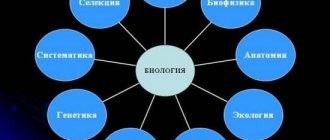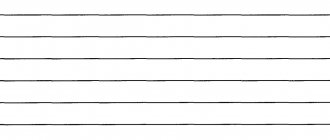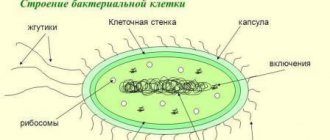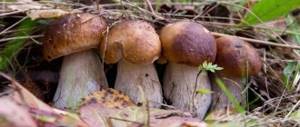Test with answers: “Biology - the science of living nature”
1. What is the name of the science that studies bacteria: a) microbiology + b) mycology c) botany
2. Science that studies animals: a) botany b) zoology + c) mycology
3. Zoology is a science that studies: a) plants b) bacteria c) animals +
4. What is the name of the science that studies plants: a) botany + b) mycology c) zoology
5. What is the name of the science that studies mushrooms: a) microbiology b) botany c) mycology +
6. Mycology is a science that studies: a) zoology b) mushrooms + c) microbiology
7. Biology is the science of: a) the structure of the Earth b) substances c) living nature +
8. Complete the sentences using words from the dictionary: The structure of the bodies of living organisms and the functioning of organs is studied by: a) biology + b) zoology c) botany
9. Complete the sentences using words from the dictionary: The problem of hunger can be solved by increasing... agricultural crops: a) death b) harvest c) productivity +
10. Complete the sentences using words from the dictionary: Biologists conduct research to prevent... animals: a) birth b) death + c) spread
11. The family of biological sciences includes: a) zoology + b) chemistry c) geography
12. The family of biological sciences includes: a) geology b) physiology + c) chemistry
13. The family of biological sciences includes: a) anatomy + b) geography c) geology
14. The family of biological sciences does not include: a) physiology b) anatomy c) chemistry +
15. The family of biological sciences does not include: a) geology + b) anatomy c) zoology
16. The first classification of animals was proposed by the ancient Greek scientist: a) Archimedes b) Aristotle + c) Euclid
17. Biological scientists create conditions for saving rare and endangered species of living organisms, is this true: a) no b) partly c) yes +
18. The relationships of organisms with the environment and with each other are studied by: a) geography b) ecology + c) physics
19. The behavior of butterflies is studied by this science: a) astronomy b) geography c) biology +
20. The structure of the bodies of living nature is explained by this science: a) geography b) biology c) ecology
21. Complete the sentences using words from the dictionary: Reproduction and development of living organisms is studied by: a) biology + b) ecology c) physics
22. Complete the sentences using words from the dictionary: The problem of hunger can be solved by increasing... animals: a) shooting b) productivity + c) mortality
23. Complete the sentences using words from the dictionary: Biological scientists conduct research to prevent environmental: a) periods b) crises c) disasters
24. The family of biological sciences includes: a) geography b) botany + c) mathematics
25. The family of biological sciences includes: a) chemistry b) mathematics c) bacteriology +
26. The family of biological sciences includes: a) geography b) zoology + c) chemistry
27. Biological knowledge is necessary to create medicines, is this true: a) yes + b) no c) partly
28. A mushroom is a body of inanimate nature, is this true: a) yes b) partly c) no +
29. Science studies the structure of plants: a) botany + b) bacteriology c) zoology
30. Bodies of living nature include: a) moon b) mushroom + c) stone
Biology. 5th grade. Test - control No. 1. Biology is the science of the living world.
Biology 5th grade. Test - control No. 1. Biology - the science of the living world. Option #1
Part A A1. The science of living nature is called: 1. Physics 2. Chemistry 3. Biology 4. Geography A2. What signs are characteristic of all living organisms: 1. Active movement 2. Breathing, nutrition, growth, reproduction 3. Absorption of mineral salts dissolved in water from the soil 4. Formation of organic substances from inorganic A3. The part of the cell where hereditary information is stored: 1. Cytoplasm 2. Nucleus 3. Vacuole 4. Cell wall A4. A young cell differs from an old one in that... 1. It has several small vacuoles, the nucleus is adjacent to the cell membrane 2. It has one large vacuole, the nucleus is adjacent to the cell membrane 3. It has one large vacuole, the nucleus is located in the center 4. B It has several small vacuoles, the nucleus is located in the center of A5. The name of the scientist who was the first to generalize the biological knowledge about animals accumulated by humanity before him: 1. Aristotle 2. Theophrastus 3. C. Linnaeus 4. C. Darwin Part B B1. Organic substances in cells include: A) mineral salts B) fats C) proteins D) carbohydrates E) water E) ash
Part C C1. A part of an organism that performs a special function and has a special structure is called……. C2. Which methods of studying living organisms are used in nature, and which in the laboratory. Give examples.
Biology. 5th grade. Test - control No. 1. Biology is the science of the living world. Option No. 2
Part A A1. The science of plants is called: 1. Botany 2. Zoology 3. Biology 4. Mycology A2. Indicate the method by which you can study the duration of hibernation in a brown bear: 1. Observation 2. Experiment 3. Comparison 4. Modeling A3. Hemoglobin is... 1. Carbohydrate 2. 3. Blood protein 4. A4 fat. Name of the hereditary material in the cell nucleus: 1. Chromosomes 2. Chloroplasts 3. Nucleolus 4. Vacuole A5. The name of the scientist who created the first system of botanical concepts: 1. Aristotle 2. Theophrastus 3. C. Linnaeus 4. Ch. Darwin Part B B1. Select the signs of living organisms: A) metabolism and energy B) irritability C) contractility D) reproduction E) absorption of light rays Part C C1. How to determine the magnification of a microscope? C2. Sketch the cell of the onion skin. Label its parts. What is the function of the cell membrane?
Biology. 5th grade. Test - control No. 1. Biology is the science of the living world. Option No. 3
Part A A1. The science of animals is called: 1. Botany 2. Zoology 3. Biology 4. Mycology A2. In an old cell, clearly visible... 1. Shell 2. Vacuole 3. Nucleus 4. Chromosomes A3. State what the experimental results prove. A little flour was stirred in water, two drops of iodine were added. The flour mixture turned blue. 1. Presence of proteins in flour 2. Presence of mineral salts in flour 3. Presence of carbohydrates - starch in flour 4. Presence of A4 fats in flour. Name the main part of the microscope: 1. Tube 2. Stage 3. Mirror 4. Stand A5. Name of the scientist who created the classification of organisms: 1. Aristotle 2. Theophrastus 3. C. Linnaeus 4. Ch. Darwin Part B B1. Find a correspondence between the names of cellular structures and their corresponding characteristics: 1. Vacuole 2. Membrane 3. Nucleus 4. Cell wall A. cell division B. cell sap C. entry of substances into the cell D. ensuring strength
Part C C1. A group of cells that are similar in structure, function and have a common origin is called ...... C2. Prove that the plant is a living organism.
5th grade. Test - control No. 1. Biology is the science of the living world. Option No. 4
Part A A1. The science of mushrooms is called: 1. Botany 2. Zoology 3. Biology 4. Mycology A2. Part of the cell containing cell sap: 1. Cytoplasm 2. Nucleus 3. Vacuole 4. Cell wall A3. State what the experimental results prove. We washed a piece of dough in a vessel with water, and a sticky, viscous mass remained in the gauze - gluten. 1. Presence of proteins in flour 2. Presence of mineral salts in flour 3. Presence of carbohydrates - starch in flour 4. Presence of A4 fats in flour. How can you see the cells in the skin of an onion? 1. Examine the skin with the naked eye 2. Examine the skin with a magnifying glass 3. Make a microslide and examine it under a microscope 4. Make a microslide and examine it with an A5 magnifying glass. The name of the scientist who explained the reasons for the diversity of living organisms: 1. Aristotle 2. Theophrastus 3. C. Linnaeus 4. Ch. Darwin Part B B1. List plant tissues: A) integumentary B) muscular C) nervous D) connective E) conductive E) mechanical
Part C C1. The method of studying nature, which uses a microscope, is called ...... C2. Sketch the cell of the onion skin. Label its parts. What function does the cytoplasm perform?
Biology. 5th grade. Test - control No. 1. Biology is the science of the living world. Option No. 5
Part A A1. The science of bacteria is called: 1. Botany 2. Zoology 3. Biology 4. Microbiology A2. Name the parts of the microscope tube: 1. Tripod and screw 2. Lens and eyepiece 3. Stage and mirror 4. Stage and lens A3. State what the experimental results prove. The seeds were crushed on a sheet of paper, creating an oil stain. 1. Presence of proteins in seeds 2. Presence of mineral salts in seeds 3. Presence of carbohydrates - starch in seeds 4. Presence of A4 fats in seeds. An ornithologist is a biologist who studies: 1. Insects 2. Worms 3. Birds 4. Frogs A5. Name of the scientist who created the doctrine of the biosphere: 1. Aristotle 2. V.I. Vernadsky 3. N.I. Vavilov 4. Ch. Darwin Part B B1. List the main parts of the cell: A) nucleus B) chloroplasts C) vacuole D) cytoplasm E) cell wall E) cell membrane
Part C C1. A living creature that has metabolism and energy, growth, development, reproduction is called - ...... C2. List the life processes of a cell.
Biology. 5th grade. Test - control No. 1. Biology is the science of the living world. Option No. 6
Part A A1. The science of living nature is called: 1. Botany 2. Zoology 3. Biology 4. Mycology A2. A cell is alive because it: 1. Covered with a membrane 2. Visible only through a light microscope 3. Breathes and feeds 4. Is a unit of structure A3. State what the experimental results prove. The seeds were burned in the test tube, leaving ash. 5. The presence of proteins in the seeds 6. The presence of mineral salts in the seeds 7. The presence of carbohydrates - starch in the seeds 8. The presence of A4 fats in the seeds. Method of studying nature, used in the laboratory using a computer: 1. Observation 2. Experiment 3. Description 4. Modeling A5. Name of the scientist who determined the centers of origin of cultivated plants: 1. Aristotle 2. V.I. Vernadsky 3. N.I. Vavilov 4. Ch. Darwin Part B: B1. List animal tissues: A) integumentary B) muscular C) nervous D) connective E) conductive E) mechanical
Part C C1. Under the shell there is a liquid substance - …….. C2. Why do human economic activities often lead to the death of living organisms? (Give at least 3 examples).
ANSWERS
Answers to test No. 1. Biology. 5th grade. Biology is the science of the living world.
Level A.
Vertical: option, Horizontal: question number.
1 2 3 4 5 1 3 2 2 4 1 2 1 1 3 1 2 3 2 2 3 1 3 4 4 3 1 3 4 5 4 2 4 3 2 6 3 3 2 4 3 Level B and C Option 1 B
-
B , V, G C1 - Organ C2 - Methods in nature: observation, description, measurement.
Methods in the laboratory: observation, experiment, modeling Option 2
B - A, B, D C1 - Magnification of the lens multiplied by the magnification of the eyepiece C2 - The cell consists of a membrane, nucleus and cytoplasm.
The main function of the cell membrane is the entry of substances into the cell. Option 3
B - 1-B, 2-B, 3-A, 4-D C1 - Tissue C2 - Living organism: metabolism and energy, growth and development, reproduction, irritability
Option 4
B - A, D, E C1 - Observation C2 – a cell consists of a membrane, nucleus and cytoplasm.
Cytoplasm is the part of the cell in which the organelles are located. 5 option
B - A, D, E C1 - Organism C2 - Cell vital processes: metabolism and energy (nutrition, respiration, excretion), growth, reproduction (division)
6 option
B - B, C, D C1 - Cytoplasm C2 - Examples of the death of living organisms as a result of human activity: - plowing of land, - deforestation, - construction of cities, - poaching, etc.
Test evaluation system:
1-5 task level A – 1 point B1 level B – 2 points C1 level C – 2 points C2 level C – 3 points Evaluation criterion
12 – 10 points – score “5” 9 – 8 points – score “4” 7 – 5 points – score “3” Less than 5 points – score “2”






